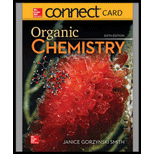
(a)
Interpretation: The product that is formed by the reaction of the given starting material with LDA in the presence of THF solution at
Concept introduction: The replacement or substitution of one
The bulky base like LDA always abstracts the proton from the side of less substituted
(b)
Interpretation: The product that is formed by the reaction of the given starting material with LDA in the presence of THF solution at
Concept introduction: The replacement or substitution of one functional group with another different functional group in any chemical reaction is termed as substitution reaction. The nucleophilic reaction that consists of bimolecular as well as bond-making and bond-breaking steps is termed as
The bulky base like LDA always abstracts the proton from the side of less substituted
(c)
Interpretation: The product that is formed by the reaction of the given starting material with LDA in the presence of THF solution at
Concept introduction: The replacement or substitution of one functional group with another different functional group in any chemical reaction is termed as substitution reaction. The nucleophilic reaction that consists of bimolecular as well as bond-making and bond-breaking steps is termed as
The bulky base like LDA always abstracts the proton from the side of less substituted
(d)
Interpretation: The product that is formed by the reaction of the given starting material with LDA in the presence of THF solution at
Concept introduction: The replacement or substitution of one functional group with another different functional group in any chemical reaction is termed as substitution reaction. The nucleophilic reaction that consists of bimolecular as well as bond-making and bond-breaking steps is termed as
The bulky base like LDA always abstracts the proton from the side of less substituted
Want to see the full answer?
Check out a sample textbook solution
Chapter 21 Solutions
ORGANIC CHEMISTRY-ACCESS
- 19. Complete the following chart for the incorrect electron configurations shown in the left column. When drawing the correct electron configuration, assume the same number of electrons that were shown in the incorrect configuration. Incorrect Electron Configuration 2p ↑↓ ↑ 2s ↑↓ 1s ↑↓↓ ਵੇ ਵੇ ਵੇ 3p ↑ ↑ ↑ - 38 ↑ 2p 2s ↑↓ 1s 2p 2s 1s ** ↑↓ ↑↓ ↑↑ 리리리 Which principle or rule is violated? Explain the violated principle or rule in your own words Draw the correct electron configurationarrow_forward14.36 Draw all reasonable resonance structures for each compound. a. + b. C. :O: d. :O: NH2 NH2 :O:arrow_forward14.32 What diene and dienophile are needed to prepare each compound by a Diels-Alder reaction? a. b.arrow_forward
- 14.34 Draw all reasonable resonance structures for each species. a. b. Ö :0: C. :0: :0: d. OH e. f. :O:arrow_forward7. The standard reduction potentials for two half-reactions are shown above. Which of the statements listed below will be true for the following reaction taking place under standard conditions? a. E° b. E° c. E° = d. E° e. E° = Al (s) + Cr³+ → Al³+ + Cr (s) 0.93 V, and the reaction is not spontaneous 0.93 V, and the reaction is spontaneous 2.39 V, and the reaction is not spontaneous 2.39 V, and the reaction is not spontaneous 0.93 V, and the reaction is spontaneous Cu2+ + 2e → Cu E° = +0.34 V Zn2+ + 2e → Zn E° = -0.76 V E° = -1.18 V Mn2+ + 2e → Mn 8. Based on the above reduction potential, which of the following reactions will occur spontaneously? a. Mn²+ + Cu → Mn + Cu2+ b. Mn²+ + Zn → Mn + Zn²+ c. Zn2+ + Cu → Zn + Cu²+ d. Zn²+ + Mn → Zn + Mn2+ e. Cu²+ + Zn²+ → Cu + Znarrow_forward14.35 For which compounds can a second resonance structure be drawn? Draw an additional resonance structure and the hybrid for each resonance-stabilized compound. a. OCH3 OCH 3 b. C. d. CH3 NHCH3arrow_forward
 ChemistryChemistryISBN:9781305957404Author:Steven S. Zumdahl, Susan A. Zumdahl, Donald J. DeCostePublisher:Cengage Learning
ChemistryChemistryISBN:9781305957404Author:Steven S. Zumdahl, Susan A. Zumdahl, Donald J. DeCostePublisher:Cengage Learning ChemistryChemistryISBN:9781259911156Author:Raymond Chang Dr., Jason Overby ProfessorPublisher:McGraw-Hill Education
ChemistryChemistryISBN:9781259911156Author:Raymond Chang Dr., Jason Overby ProfessorPublisher:McGraw-Hill Education Principles of Instrumental AnalysisChemistryISBN:9781305577213Author:Douglas A. Skoog, F. James Holler, Stanley R. CrouchPublisher:Cengage Learning
Principles of Instrumental AnalysisChemistryISBN:9781305577213Author:Douglas A. Skoog, F. James Holler, Stanley R. CrouchPublisher:Cengage Learning Organic ChemistryChemistryISBN:9780078021558Author:Janice Gorzynski Smith Dr.Publisher:McGraw-Hill Education
Organic ChemistryChemistryISBN:9780078021558Author:Janice Gorzynski Smith Dr.Publisher:McGraw-Hill Education Chemistry: Principles and ReactionsChemistryISBN:9781305079373Author:William L. Masterton, Cecile N. HurleyPublisher:Cengage Learning
Chemistry: Principles and ReactionsChemistryISBN:9781305079373Author:William L. Masterton, Cecile N. HurleyPublisher:Cengage Learning Elementary Principles of Chemical Processes, Bind...ChemistryISBN:9781118431221Author:Richard M. Felder, Ronald W. Rousseau, Lisa G. BullardPublisher:WILEY
Elementary Principles of Chemical Processes, Bind...ChemistryISBN:9781118431221Author:Richard M. Felder, Ronald W. Rousseau, Lisa G. BullardPublisher:WILEY





